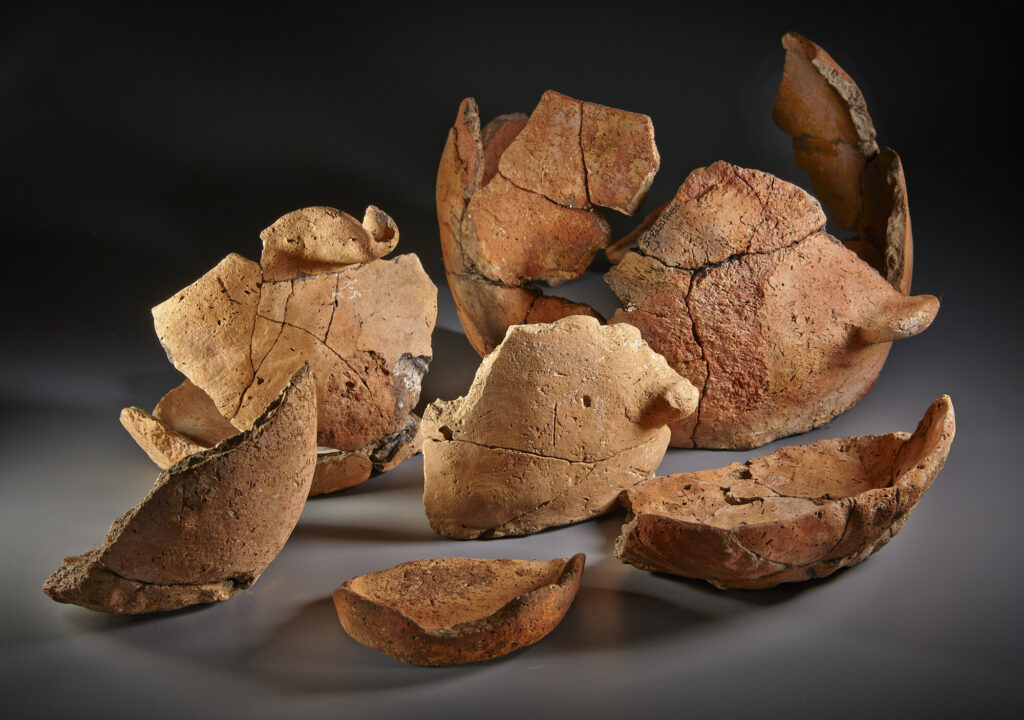
The Kuwaiti-Polish Archaeological Mission (KPAM) finished this year’s season of work at Bahra 1, a prehistoric site in the
Al-Subiyah desert of Northern Kuwait. Dating back to the mid-6th millennium BCE, Bahra 1 is among the oldest and largest known settlements in the Arabian Peninsula.
Since 2009, Bahra 1 has been a focal point for archaeological research, a collaboration between Kuwait’s National Council of Culture, Arts, and Letters (NCCAL) and the Polish Centre of Mediterranean Archaeology, University of Warsaw (PCMA UW). The Polish side of the expedition is headed by Prof. Piotr Bieliński, with Dr. Agnieszka Pieńkowska as acting director this season, (both of the PCMA UW), while the Kuwaiti hosts are represented by Mr. Mohammad ben Redha, General Director of the Department of Antiquities and Museums of the NCCAL.

Photo: A.Oleksiak / PCMA UW
The ongoing excavations reveal Bahra 1 as a critical site for understanding the cultural exchanges between Arabian Neolithic societies and the Ubaid culture which spread from Mesopotamia to a vast territory, from Anatolia to the Arabian Peninsula. Recent research at Bahra 1 contributed new information to the picture through several unique discoveries.
One of the most remarkable, although tiny, discoveries is a small, finely crafted clay head featuring an elongated skull, slanting eyes, and a flat nose. Similar features are characteristic of figurines from the Ubaid culture. Figurines of this type have been found in both grave and domestic contexts in Mesopotamia, but this discovery at Bahra 1 marks the first of its kind in the Gulf region. “Its presence raises intriguing questions about its purpose and the symbolic, or possibly ritualistic, value it held for the people of this ancient community,” – says Prof. Piotr Bieliński who studied the piece. Another pivotal discovery at Bahra 1 involves evidence of local pottery production. From their onset, excavations at the site have yielded two types of pottery: Ubaid are, known to have been imported from Mesopotamia, and a completely different type known as Coarse Red Ware (CRW) and known from sites in the Arabian Peninsula.

Photo A. Oleksiak / PCMA UW
The latter type has long been described as produced locally, in the Gulf region, but actual places of its production have hitherto remained unknown. Conclusive evidence finally came from the Bahra 1 site, including an unfired clay vessel. These findings, as well as scientific analyses conducted under the direction of Prof. Anna Smogorzewska, confirm Bahra 1 as the oldest known pottery production site in the Gulf.

Photo A. Oleksiak / PCMA UW
The local pottery production has also opened a window into the region’s environmental history which can be investigated through archaeobotanical analyses. That is because small fragments of plants, such as chaff, are often added to clay during the vessel-making process. Such organic remains were also embedded in the clay of both the Ubaid ware and the CRW pottery. This season, Dr. Roman Hovsepyan and Prof. Aldona Mueller-Bieniek, specialists in archaeobotany, examined selected pottery fragments for traces of plants that might help identify local flora from the mid-6th millennium BCE. – “Early analyses have revealed traces of wild plants, particularly reed, within the locally produced pottery, while cultivated plant remains, including cereals, such as barley and wheat, have been found in the imported Ubaid ware,” – explains Dr. Hovsepyan.

Photo M. Antos / PCMA UW
The results of the work were shared with representatives of the NCCAL, including
Dr. Mohammad Al-Jassar, Secretary General of the NSSAL and Dr. Hassan Ashkanani, Advisor to the S.G. of the NCCAL, who visited the Bahra 1 site, and took part in an official meeting initiated by the Embassy of Poland. In the course of the season, the KPAM team also offered training on the various categories of finds and introduction to fieldwork techniques to employees of the National Museum in Kuwait.

Photo M. Antos/CAŚ UW
KPAM’s work at Bahra 1 promises to yield further discoveries and insights into the intersection of the Arabian Neolithic and Mesopotamian Ubaid cultures as well as to develop further cooperation between Polish and Kuwaiti heritage specialists.
Read more about Bahra 1
Source: Polish Centre of Mediterranean Archaeology, University of Warsaw (PCMA UW) coordinates Polish archaeological research in the Eastern Mediterranean since 1959 (since 1990 under the present name). In recent years, it broadened its scope of interest into the Arabian Peninsula and the Caucasus. Currently about 20 projects are ongoing in Egypt, Sudan, Tunisia, Cyprus, Lebanon, Kuwait, Oman, Georgia and Armenia. The PCMA UW also runs Research Centres in Egypt, Sudan, Cyprus and Georgia.
Learn more: https://pcma.uw.edu.pl/en/ Fb @pcma.uw Insta @pcma_uw X(Tt) @PCMA_UW YT @PCMAUW Kuweit
